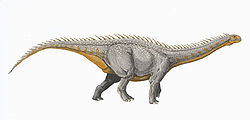
Kota Formation
Encyclopedia
The Kota Formation is a geological formation in India. It dates back to the Hettangian
-Pliensbachian
.
Hettangian
The Hettangian is the earliest age or lowest stage of the Jurassic period of the geologic timescale. It spans the time between 199.6 ± 0.6 Ma and 196.5 ± 1 Ma . The Hettangian follows the Rhaetian and is followed by the Sinemurian.In Europe stratigraphy the Hettangian is a part of the time span in...
-Pliensbachian
Pliensbachian
The Pliensbachian is an age of the geologic timescale or stage in the stratigraphic column. It is part of the Early or Lower Jurassic epoch or series and spans the time between 189.6 ± 1.5 Ma and 183 ± 1.5 Ma . The Pliensbachian is preceded by the Sinemurian and followed by the Toarcian.The...
.
Vertebrate paleofauna
Indeterminate thyreophoran remains geographically present in Andhra Pradesh State, India.| Ornithodires reported from the Kota Formation | ||||||
|---|---|---|---|---|---|---|
| Genus | Species | Location | Stratigraphic position | Material | Notes | Images |
Barapasaurus Barapasaurus Barapasaurus is a genus of sauropod dinosaur from Early Jurassic rocks of India. The specific name for its only species, B. tagorei, means 'Tagore's', which honors Bengali poet, writer, painter, and musician Rabindranath Tagore.-Description:... |
B. tagorei |
Geographically present in Andhra Pradesh State, India. |
"Scattered remains of more than [six] partial skeletons without skulls, manus, or pes." |
  |
||
Campylognathoides Campylognathoides Campylognathoides was a genus of "rhamphorhynchoid" pterosaur, discovered in the Württemberg Lias deposits, the first specimen consisting of wing fragments... |
C. indicus |
Geographically present in the Chanda District of Deccan India. |
||||
Dandakosaurus Dandakosaurus Dandakosaurus is a genus of theropod dinosaur from Andhra Pradesh, India. It lived 183 - 175 million years ago in the Toarcian, Early Jurassic. It is currently classified as Neoceratosauria incertae sedis but may in fact be a ceratosaurid or basal tetanuran.The type species, D. indicus, was named... |
D. indicus |
"Proximal pubis." |
Later found to be indeterminate theropod remains. |
|||
Kotasaurus Kotasaurus Kotasaurus is the name given to a genus of dinosaur from the Early Jurassic period, about 208 million to 188 million years ago. It was an early sauropod, sharing some similarities with prosauropods... |
K. yamanpaliensis |
Geographically present in Andhra Pradesh State, India. |
"Nearly complete skeleton without skull." |
|||
Invertebrate paleofauna
| Insect Insect Insects are a class of living creatures within the arthropods that have a chitinous exoskeleton, a three-part body , three pairs of jointed legs, compound eyes, and two antennae... s of the Kota Formation |
||||||
|---|---|---|---|---|---|---|
| Genus | Species | Location | Stratigraphic position | Material | Notes | |
Kotaphialtites |
K. frankmortoni |
Geographically present in Andhra Pradesh State, India. |
An ephialtitid hymenoptera Hymenoptera Hymenoptera is one of the largest orders of insects, comprising the sawflies, wasps, bees and ants. There are over 130,000 recognized species, with many more remaining to be described. The name refers to the heavy wings of the insects, and is derived from the Ancient Greek ὑμήν : membrane and... n. |
|||
Taschigatra |
T. bharataja |
Geographically present in Andhra Pradesh State, India. |
A rhagionid Rhagionidae Rhagionidae or snipe flies are a small family of flies containing 21 genera.-Description:Rhagionidae are medium-sized or large flies with slender bodies and stilt-like legs. The mouthparts are adapted for piercing and many species are haematophagous as adults, while others are predatory on other... diptera Diptera Diptera , or true flies, is the order of insects possessing only a single pair of wings on the mesothorax; the metathorax bears a pair of drumstick like structures called the halteres, the remnants of the hind wings. It is a large order, containing an estimated 240,000 species, although under half... n. |
|||
T. tulyabhijana |
Geographically present in Andhra Pradesh State, India. |
A rhagionid Rhagionidae Rhagionidae or snipe flies are a small family of flies containing 21 genera.-Description:Rhagionidae are medium-sized or large flies with slender bodies and stilt-like legs. The mouthparts are adapted for piercing and many species are haematophagous as adults, while others are predatory on other... diptera Diptera Diptera , or true flies, is the order of insects possessing only a single pair of wings on the mesothorax; the metathorax bears a pair of drumstick like structures called the halteres, the remnants of the hind wings. It is a large order, containing an estimated 240,000 species, although under half... n. |
||||
Xyelula |
X. alexandri |
Geographically present in Andhra Pradesh State, India. |
A sepulcid Sepulcidae Sepulcidae is a family of extinct hymenopteran insects. The family is known primarily from late Mesozoic fossils found in 1968 in Transbaikalia. The insects were distant relatives of modern sawflies.... hymenoptera Hymenoptera Hymenoptera is one of the largest orders of insects, comprising the sawflies, wasps, bees and ants. There are over 130,000 recognized species, with many more remaining to be described. The name refers to the heavy wings of the insects, and is derived from the Ancient Greek ὑμήν : membrane and... n. |
|||

